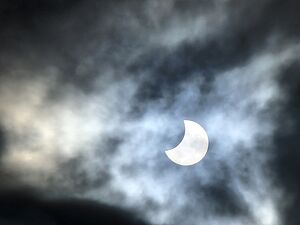IAP measures effects of the solar eclipse in the atmosphere
35-percent occultation over Juliusruh / Wandering ionospheric disturbances investigated

That the sun influences events in the atmosphere is commonly known in research. But what happens when solar radiation no longer reaches the Earth? The Leibniz Institute of Atmospheric Physics (IAP) is investigating this effect on Tuesday, when the moon partially obscures the sun. The institute in Kühlungsborn is participating in a Europe-wide ionosonde campaign.
Ten measuring stations throughout Europe will accompany the partial solar eclipse. The only one in Germany is located in Juliusruh on the island of Rügen, where the IAP operates a field site. "The sun is the strongest source of ionization in the atmosphere," says Jens Mielich, an engineer at the IAP in Juliusruh. "With our ionosonde - a special radar for studying the ionosphere - we measure whether wandering ionospheric disturbances or waves are formed by a dimming by the moon, and if so, how strong they are and where they propagate."
To do this, the engineer is creating time-resolved ionograms that record new data from the atmosphere every 30 seconds. He expects slight waves emanating from the moon's shadow toward the southwest. "But I think the effect will be rather weak for the atmosphere. The sun is just too low for that," Mielich said.
Around 12:12 the darkening of the sun over Rügen is strongest - about 35 percent. "Hardly visible to the naked eye - if it's cloudy, not at all," says Jens Mielich. Those who are in Western Siberia in the afternoon around 4 p.m. (Central European Time) would have better chances to observe the eclipse - there, the moon covers 80 percent of the sun. The ionosonde campaign on October 25 is coordinated from Belgium.












